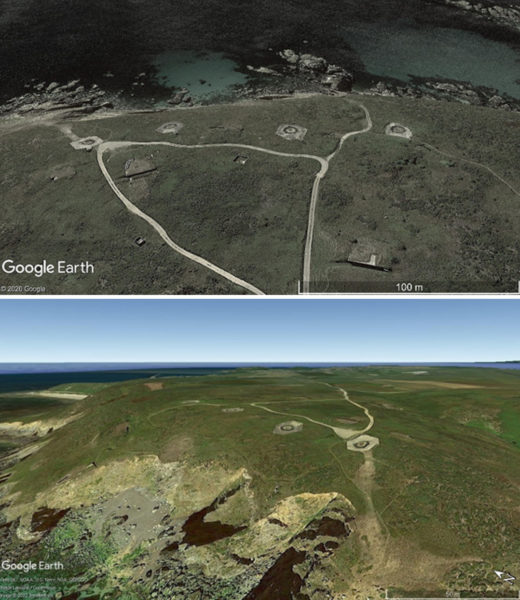Westbatterie
- Country: Alderney, The Channel Islands
- GPS: 49° 42' 28.6812 N, -2° 13' 50.16 W,
- Address: Westernmost end of the island, close to Lager Sylt
- Operational: N/A - Active
By Caroline Sturdy Colls and Kevin Colls
Several places on Alderney were viewed as the worst places to work by Organisation Todt (OT) labourers and an examination of both testimonies and the locations reveals the gruelling conditions they were subjected to. From 1942 onwards, Westbatterie (later known as Battery Annes) became synonymous with ill-treatment. Located in the vicinity of Sylt labour camp and drawing upon its OT inmates, this fortification complex apparently had the highest mortality rate of all of the work sites on the island.1 Here, labourers constructed a naval coastal artillery battery, complete with a command post, gun emplacements, bunkers, personnel shelters and searchlight positions to ‘fortress standard specifications’.2
Deep excavations, a dangerous coastal location and exposure to harsh winds were just some of the elements that greeted those working here. OT labourer Georgi Kondakov described what the workers called a ‘wedding’ at Westbatterie during which they were forced to work for 36 hours in terrible weather with poor rations and few breaks to rapidly build elements of the fortification complex.3 He stated: ‘the second day of this awful labour had started. The hands could scarcely hold the shovel, we had no strength left to move, and only the idea that moving postponed death, kept us working’.4 During this ‘wedding’, which occurred in January 1943, six out of 150 men reportedly went missing and likely succumbed to the terrible working conditions. Beatings were also common here. Jacques Pierre Chansalme is one of many witnesses who describe such brutality; he saw a Jew being hit over the head by an ‘ordinary OT man’ with a pick that he was using.5 Ivan Kalganov, an inmate at Sylt labour camp, was another labourer who witnessed severe brutality against his fellow inmates. He also noted that clandestine food given to him at Westbatterie by a German soldier saved his life.6
Inmates from Sylt camp were not the only ones to work at this notorious site. To increase the level of suffering, prisoners were often marched to worksites at the opposite end of the island rather than the worksites their camps were closest to.7 Théodore Haenel, an inmate of Norderney, recalled 10- 14 hours of intense hard labour here followed by a long walk back to camp.8
References:
1 Georgi Kondakov in Bonnard, B. 1991 The Island of Dread in the Channel. Sutton Publishing Ltd. p. 50.
2 Davenport, T. 2003 Festung Alderney. The Alderney Society, p. 45; C. Sturdy Colls and K.S. Colls. ‘Adolf Island’: The Archaeology of the Occupation of Alderney (Manchester: Manchester University Press, 2022).
3 Georgi Kondakov in Bonnard, B. 1991 The Island of Dread in the Channel. Sutton Publishing Ltd. p. 63; another example of these ‘concrete pours’ is described by Gordon Prigent in IWM, MISC 2826, 189/2, Nr. 4390 and 4391, ‘Interview with Gordon Prigent’, undated and in AG-NG, 1515, ‘Ernst Fischelâ’, undated.
4 Georgi Kondakov in Bonnard, B. 1991 The Island of Dread in the Channel. Sutton Publishing Ltd. p. 63.
5 TNA, WO311/12, ‘Statement of Jacques Pierre Chansalmeâ’, 18 May 1945.
6 Ivan Kalganov in Bunting, M. 1996 The Model Occupation: The Channel Islands Under German Rule 1940-45. Harper Collins, pp. 168, 269 and 273. 7 Jersey Heritage Trust, ‘Mr Prigent’, www.jerseyheritagetrust.org/edu/resources/ pdf/prigent.pdf (accessed 14 April 2009): A, AQ875/03, ‘Testimony of Senior Cavalry Sergeant Major Fritz Veeman’,
7 June 1945: TNA, WO311/12, ‘Statement of Miss Annie Kathleen Le Cheminant’, 2 June 1945.
8 Haenel, in Luc, Les déportés de France vers Aurigny, pp. 157–165
Map
- Cemetery / Mass Grave
- Concentration Camp
- Forced Labour Camp
- Prison
- Worksite / Fortification

